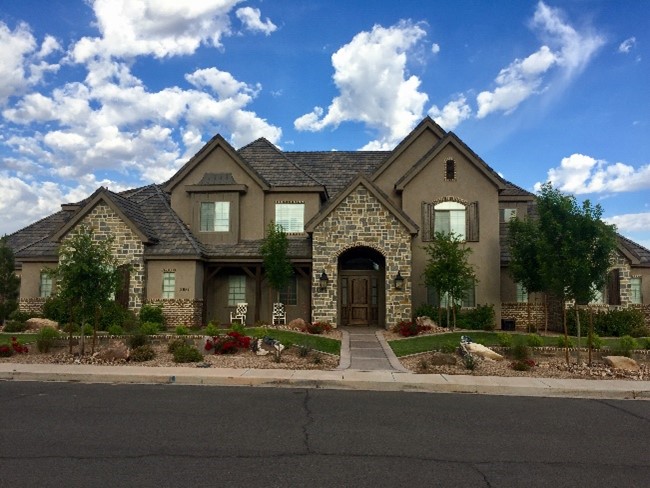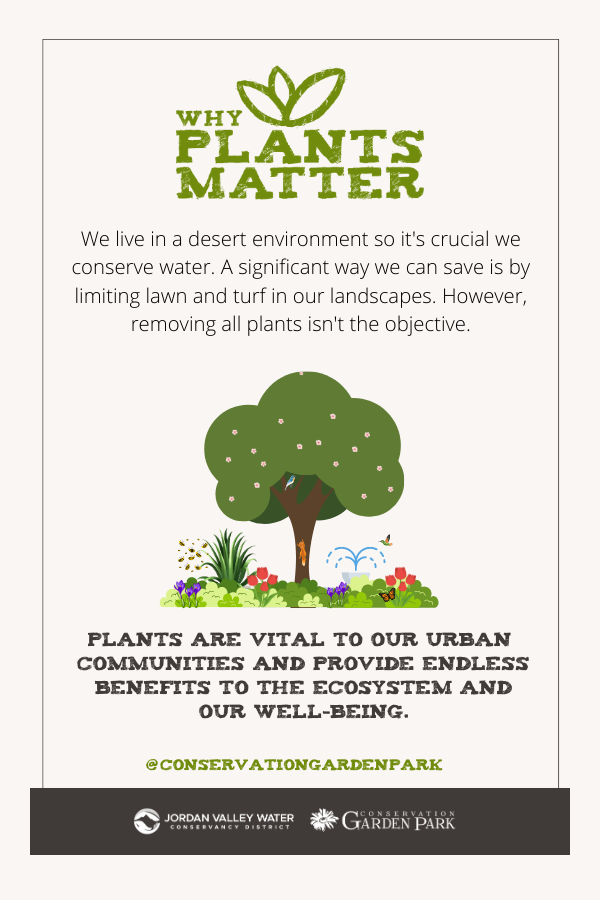
Why Plants Matter
-
Conserving Smartly: Why Plants MatterHere at Conservation Garden Park, we are often asked, “If you are trying to reduce water usage, why is it important to include plants in your landscape? Doesn’t that just require more water?” In short, the answer is yes. Plants do require more water than rock or concrete, but with the switch from overhead spray to drip irrigation, the reduction of lawn, and the incorporation of native, or adapted, waterwise plants, we will see mass amounts of water being saved without going to an extreme.Plants do require water, but it is vital to include them in our landscapes. Plants provide numerous benefits and without them our entire environment would change. Through using waterwise practices and waterwise plants, we can conserve water while still being able to enjoy the benefits plants provide. Listed below are several reasons why plants are crucial to us.
-

-
The Urban Heat Island EffectAs cities lose natural spaces and trees, they begin to experience something called the "Urban Heat Island Effect", in which urban areas heat up significantly more than surrounding areas. Buildings, roads, and other infrastructure absorb and re-emit the sun’s heat more so than greenery and natural landscapes (source).The EPA says that heat islands increase energy costs from air conditioning, contribute to air pollution, and cause heat-related illnesses and mortality (source). They are bad for our communities in terms of economics, wellbeing, and health.Plants cool the area around them by moving moisture through the air (through evapotranspiration), shading surfaces, and deflecting solar radiation. Conventional roofing materials can reach as high as 60°F warmer than the air on a warm day. Incorporating plants into urban and residential landscapes reduces temperatures, saves energy and money on cooling expenses, and improves outdoor comfort during heat extremes.
-

-
Water FiltrationSurface area covered by buildings and pavement also changes patterns in water runoff and absorption. Impermeable surfaces (like asphalt, roofing, and concrete) shed stormwater, directing it into storm drains and the ground. Flooding results when the ground is not permeable enough to absorb all the water. Plant roots break up compacted soil and create space for the water to absorb properly, reducing the chances of flooding.As water moves across the ground it picks up contaminants such as road salts, car pollution, pesticides, and fertilizers. Plant roots can filter out those contaminants as the water travels through the soil, making for cleaner groundwater. Urban plants play a vital role in keeping our water system clean.
-

-
Beautification, Popularity, and City OrdinancesBeautifying our streets is a major priority for most cities and homeowners. Having plants in our neighborhoods and urban environments helps to boost mood, improve well-being, and reduce stress. It also helps to improve curb appeal and property values. Studies have shown that street trees may even reduce crime by 12%!
-

-
Soil StabilizationWithout plants and trees to help us stabilize our soils, erosion occurs, which can lead to both environmental and structural damage. Different plants, such as ground cover, native grasses, and shrubs have different benefits including soil surface protection, soil stabilization, and buffering against flowing water.Plants with lots of spreading fibrous roots can anchor through the soil and help to hold the soil in place below the top layers, protecting against erosion and aiding on slopes. Plants with a lot of leaves help to break the impact of raindrops before they hit the ground, thus helping to prevent soil runoff. Plants can also help slow down the water as it moves across the soil surface. The plants become obstacles that the water must move around, decreasing the speed of movement. Slowing down the water movement can also help keep the soil in place and prevent it from washing away. These benefits are even more prominent in more densely planted areas.Ensuring soil stability is critical for ensuring long-term soil health and preventing water and wind erosion. When it comes to erosion control, planting areas can be customized with plants that help with specific erosion issues.
-

-
Wildlife HabitatNative and adapted non-native plant species provide habitat for various native creatures, including pollinators, insects, arachnids, birds, rabbits, and more! Plants provide food, protection, and places to raise young, which are all vital to maintaining a healthy community and ecosystem.Rather than removing non-native and high-water use plants and replacing them with hardscape, replace them with native, or adapted, waterwise plants to encourage a healthy habitat. Once you have used sustainable practices to revamp your landscape, and have included resources like food, water, cover, and places to raise young, you can even register it as a Certified Wildlife Habitat through the National Wildlife Federation (NWF Certification)!For all the reasons listed above and many more, plants matter. Adding plants to our landscapes and cities makes them more livable and enjoyable now, while also allowing us to invest in their future health.
-

-
Wildlife HabitatNative and adapted non-native plant species provide habitat for various native creatures, including pollinators, insects, arachnids, birds, rabbits, and more! Plants provide food, protection, and places to raise young, which are all vital to maintaining a healthy community and ecosystem.Rather than removing non-native and high-water use plants and replacing them with hardscape, replace them with native, or adapted, waterwise plants to encourage a healthy habitat. Once you have used sustainable practices to revamp your landscape, and have included resources like food, water, cover, and places to raise young, you can even register it as a Certified Wildlife Habitat through the National Wildlife Federation (NWF Certification)!For all the reasons listed above and many more, plants matter. Adding plants to our landscapes and cities makes them more livable and enjoyable now, while also allowing us to invest in their future health.


